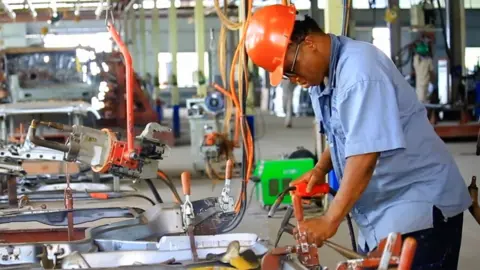The challenge of creating successful Nigerian products
 BBC
BBCIn a bid to diversify its economy following the 2016 recession, Nigeria is looking to boost its manufacturing capabilities.
The "business hub" of Africa, Nigeria is home to the continent's biggest population and biggest economy.
But the challenge lies in convincing Nigerians to pick locally made products over imported goods.
One firm trying to build its brand is food and beverage manufacturer Rite Foods.
The company has a factory located three hours outside Lagos, where it makes a range of soft drinks, mineral water and snacks like sausage rolls.
"If anything, being a Nigerian-owned brand initially would almost become a negative, because people think that what is produced locally just can't be as good, but what we've been able to do in the last 28 months is to show that no, actually you can be a proud Nigerian brand," Rite Foods' managing director Seleem Adegunwa told the BBC.
But manufacturing in the country comes with a whole host of other challenges as well.
"Everything is a challenge. You have to produce the power [to run the plant] yourself, because you're not on the grid," explained Mr Adegunwa.
And then there's gaining access to markets.

In 2015, African consumers spent an estimated $1.4 trillion (£1.1tn), according to research firm McKinsey, and by 2025, consumer spending is expected to top $2tn (£1.5tn).
South Africa, Nigeria and Egypt made up more than half of that total.
Nigeria is home to 200 million people, and its consumer market is estimated to be worth $150bn, which means there's a lot of potential for growth, although there is stiff competition from international brands both in the continent and abroad.
"Nigeria just came out of a recession, and after the recession there were some adjustment policies that took place. The currency lost about 60% of its value," finance expert Bismarck Rewane told the BBC.
"All of this has made homemade goods much more competitive than imported goods, so people will have taken advantage of the currency value, the size of the market, the changing demographic and the fact that there is growth taking place after six quarters of negative growth."
